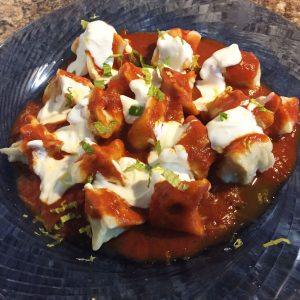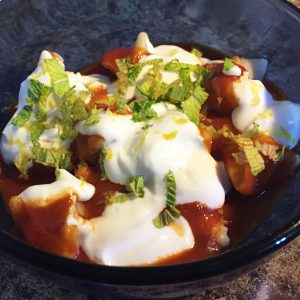| Servings |
|
- 3-4 pound roast of venison or beef chuck
- 1 bottle of red wine
- 2 cups water
- 1 Tbsp black peppercorns
- 1 Tbsp juniper berries
- 1 Tbsp mustard seed
- 6-8 cloves
- 3-5 bay leaves
- 1 Tbsp dried thyme
- 2 celery stalks chopped
- 2 carrots peeled and chopped
- 1 medium onion chopped
- 1/4 cup melted butter or olive oil
- 8 ginger snap cookies
- 3 Tbsp butter
- 2 Tbsp flour
- salt
Ingredients
|
|
- Bring marinade ingredients to a boil and turn off the heat. Allow to cool. Submerge the venison in the marinade and let it sit in the fridge for at least 24 hours, and up to 5 days. Three days is a good length of time. When you are ready to cook, take the roast out of the marinade and salt it well. Set it aside for 15-20 minutes or so.
- Preheat the oven to 275 degrees. Actually, 225 is a better temperature, but the roast can take up to 8 hours to properly cook then; this is what I do at home on weekends. At 275 degrees, the roast will probably take about 5 hours to cook. You can go up to 300 degrees – a typical venison roast will be ready in 3 1/2 hours at this temperature – but you will get gray, not pink, meat. It will still taste good, though.
- Now you have an optional step: You can, if you choose, brown the venison in butter or oil. I chose not to because if you then simmer the venison at a low enough temperature, it will remain pink all the way through. If you brown the outside, you will get a gray ring around the edge of the venison when you cut into it. Either way is fine.
- Pour the marinade into a pot and bring it to a boil. Pour it into a Dutch oven or other lidded pot and place the venison inside. Cover and put in the oven. If the venison is not submerged by the marinade, turn the roast over every hour. This is also a good way to test for doneness – you want the roast to almost be falling apart. When the roast is done, take it out of the pot and coat it with some of the 1/4 cup olive oil or melted butter. Reserve the rest of the oil or butter for later. Wrap it in foil.
- Now you make the sauerbraten sauce – and sauerbraten is all about the sauce. Strain the cooking liquid through a fine-meshed sieve into a bowl. Take the 8 ginger snap cookies and pulverize them in a blender. You want it to look like a rough meal or coarse flour.
- In a medium-sized pot, melt 3 tablespoons of butter over medium-high heat. When it is frothing and totally melted, whisk in 2 tablespoons flour. Cook until it is the color of coffee-and-cream, stirring often. Slowly whisk in the cooking liquid, one cup at a time. The mixture will turn to clay at first, then loosen into a silky sauce. Taste for salt – it will probably need it – and add enough to your taste.
- Whisk in 4 tablespoons of the pulverized ginger snaps. They will not dissolve completely at first, but keep stirring and they will disappear. Taste the sauce. Add another tablespoon of ginger snaps if you want, or add a tablespoon of sugar. The sauce should taste sour, warm (a pumpkin pie sort of spicy warm) and a little zippy and sweet.
- To serve, slice the roast into 1/4 inch thick slices. Venison can be dry – it has zero fat – so one trick I do is to coat each slice in melted butter before I serve it. You’ll need about 1/2 stick melted to do this trick. Serve with lots of sauce, some braised onions, and either mashed potatoes, egg noodles, or spaetzle. A hearty red wine would be an ideal match here, as would a dark, malty beer.
You can of course use beef for this recipe; brisket or a chuck roast would be good, and you could also use London broil or tri-tip.


